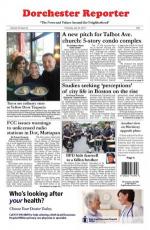July 18, 2013
Neighborhoods across the city could soon experience a surge in small farms and produce growers, as the Boston Redevelopment Authority approaches changes in how it regulates urban agriculture.
On Tuesday in Codman Square, in the seventh of eleven planned meetings in Boston’s neighborhoods, officials laid out the proposed zoning and regulation changes that would introduce small-scale farming to vacant lots, backyards, and rooftops from Charlestown to Mattapan and across the rest of the city.
The plan, known as Article 89, is currently in draft form and will be finalized after the meeting series concludes at the end of this month.
“Article 89 addresses a pretty wide variety of urban agriculture issues,” said John “Tad” Read, a senior planner at the BRA. The plan covers commercial farming and transportation only, farms selling their produce to others, and does not affect common backyard gardening.
About 30 people, many local farmers and other interested parties, attended a meeting at the Great Hall on Tuesday evening.
Read said the plan was put in motion after Mayor Thomas Menino heard of an entrepreneur who could not legally grow mixed greens to sell to a restaurant. Menino established a working group made up of city officials and experts and asked the BRA to open up the regulations on urban farming.
Read and fellow BRA senior planner Marie Mercurio listed some of the many benefits the city could experience from expanded urban farming, including lower shipping costs for fresher produce, employment opportunities, community development, educational benefits, and the use of vacant land.
During the presentation, the crowd was shown photos of existing urban farms, including a ground-level field on a lot on West Cottage Street in Dorchester. Up to one acre of farmland will be allowed in all zoning areas of the city, Read said, with larger sites subject to further Zoning Board of Appeals approval. Other farming options will include greenhouses and rooftop farms. Farms built atop existing structure can be up to 5,000 square feet under Article 89, according to Mercurio, who said neighbors views and lighting issues were taken into consideration while deliberating the regulations. “It’s definitely coming to Boston quickly,” Mercurio said of the new farms.
Farming in urban settings, where years of use and development have left much of the soil contaminated, requires farmers to import fresh soil from other areas. A barrier is then placed between the native and imported soil and raised boxes are usually constructed to protect the crops.
Another area covered by Article 89 involves changes in the way the city regulates the keeping of hens and bees. Currently, only a few small slivers of industrially zoned space allow for hens and bees and the new plan would relax those regulations. The proposal lays out details of how chicken coops should be built and introduces a maximum of six hens per lot. Beehives, two of which will be allowed per lot, must be no greater than five feet.
Comments gathered at the meetings will be heard at a September meeting of the working group before a new draft of Article 89 is taken up by the BRA in October. By the end of the year, Read said, he expects the ZBA to hear and adopt a final plan.
Topics:



